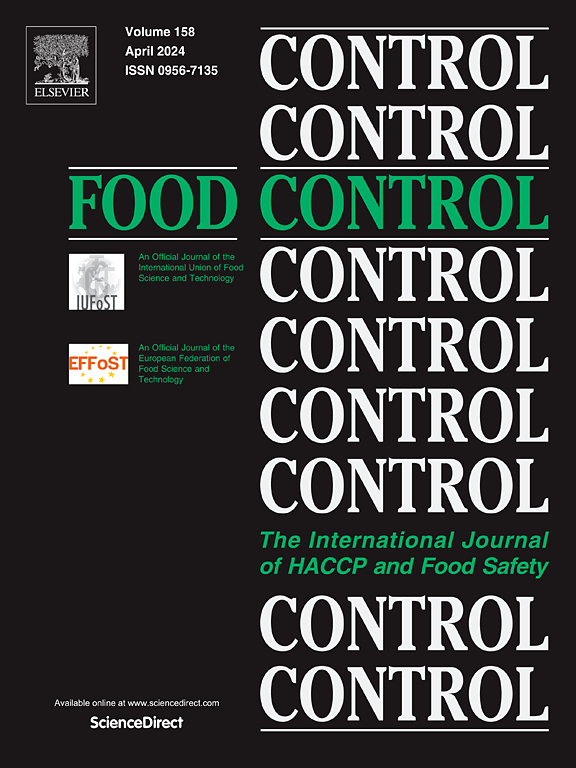Treatment of table olives with 1-methylcyclopropene, heat shock, and dimethyl dicarbonate impacts the microbial fermentation profile and composition of the fruit biofilm
IF 5.6
1区 农林科学
Q1 FOOD SCIENCE & TECHNOLOGY
引用次数: 0
Abstract
In this study, we used an experimental design to assess the influence of 1-methylcyclopropene (1-MCP), a mild heat shock, and dimethyl dicarbonate (DMDC) on microbial evolution in brines and the biofilm composition of Spanish-style and naturally fermented table olives. Data were statistically analyzed using classical and compositional data analysis (CoDA). In the brines, the natural processing style raised the presence of yeast/fungi, while heat shock increased the populations of lactic acid bacteria populations. The interaction among heat shock, natural fermentation, and DMDC favored the survival of Enterobacteriaceae. Concerning biofilms, the metataxonomic analysis showed that the five most frequently detected bacterial genera were Lactiplantibacillus (66.79%), Secundilactobacillus (15.12%), Pediococcus (7.50%), Marinilactibacillus (4.92%), and Enterobacter (3.88%), while most common fungal genera were Saccharomyces (63.13%), Bannoa (11.49%), Candida (8.34%), Wickerhamomyces (4.15%), and Kluyveromyces (2.04%). Treatments also affected microbial diversity in biofilms. Adding DMDC significantly reduced the number of bacterial taxa compared to untreated olives. Additionally, the Spanish-style processing resulted in lower bacterial diversity. In contrast, fungi displayed an opposite trend, with the highest similarity found in naturally processed olives. CoDA revealed that the bacterial genera Marinilactibacillus and Lactiplantibacillus were characteristic of Spanish-style olives, while Secundilactobacillus and Pediococcus were associated with naturally processed olives. For fungi, Saccharomyces was related to both Spanish-style and naturally processed olives. The results indicate that the treatments influenced bacterial and fungal populations in brines and olive biofilms and their relationships. These effects may help modulate/control the microbial evolution during olive fermentation.
用 1-甲基环丙烯、热冲击和二甲基碳酸氢盐处理食用橄榄会影响微生物发酵概况和果实生物膜的组成
在这项研究中,我们采用实验设计来评估 1-甲基环丙烯(1-MCP)、轻度热冲击和二甲基碳酸氢盐(DMDC)对盐水中微生物进化以及西班牙式和自然发酵食用橄榄的生物膜组成的影响。采用经典数据分析和成分数据分析(CoDA)对数据进行了统计分析。在盐水中,自然加工方式增加了酵母菌/真菌的存在,而热冲击则增加了乳酸菌的数量。热冲击、自然发酵和 DMDC 之间的相互作用有利于肠杆菌的存活。关于生物膜,元分类分析表明,最常检测到的五个细菌属是乳杆菌(66.79%)、半乳杆菌(15.12%)、木薯球菌(7.最常见的真菌属有酵母菌属(63.13%)、班诺亚菌属(11.49%)、念珠菌属(8.34%)、威克酵母菌属(4.15%)和克鲁酵母菌属(2.04%)。处理方法也会影响生物膜中的微生物多样性。与未经处理的橄榄相比,添加 DMDC 能明显减少细菌类群的数量。此外,西班牙式加工也降低了细菌的多样性。相比之下,真菌则呈现出相反的趋势,自然加工的橄榄中真菌的相似度最高。CoDA显示,马林尼巴氏杆菌属(Marinilactibacillus)和莱特巴氏杆菌属(Lactiplantibacillus)是西班牙式橄榄的特征菌属,而塞康迪乳酸杆菌(Secundilactobacillus)和木薯球菌(Pediococcus)则与自然加工橄榄有关。在真菌方面,酵母菌与西班牙式橄榄和天然加工橄榄都有关系。结果表明,处理方法会影响盐水和橄榄生物膜中的细菌和真菌数量及其关系。这些影响可能有助于调节/控制橄榄发酵过程中的微生物进化。
本文章由计算机程序翻译,如有差异,请以英文原文为准。
求助全文
约1分钟内获得全文
求助全文
来源期刊

Food Control
工程技术-食品科技
CiteScore
12.20
自引率
6.70%
发文量
758
审稿时长
33 days
期刊介绍:
Food Control is an international journal that provides essential information for those involved in food safety and process control.
Food Control covers the below areas that relate to food process control or to food safety of human foods:
• Microbial food safety and antimicrobial systems
• Mycotoxins
• Hazard analysis, HACCP and food safety objectives
• Risk assessment, including microbial and chemical hazards
• Quality assurance
• Good manufacturing practices
• Food process systems design and control
• Food Packaging technology and materials in contact with foods
• Rapid methods of analysis and detection, including sensor technology
• Codes of practice, legislation and international harmonization
• Consumer issues
• Education, training and research needs.
The scope of Food Control is comprehensive and includes original research papers, authoritative reviews, short communications, comment articles that report on new developments in food control, and position papers.
 求助内容:
求助内容: 应助结果提醒方式:
应助结果提醒方式:


